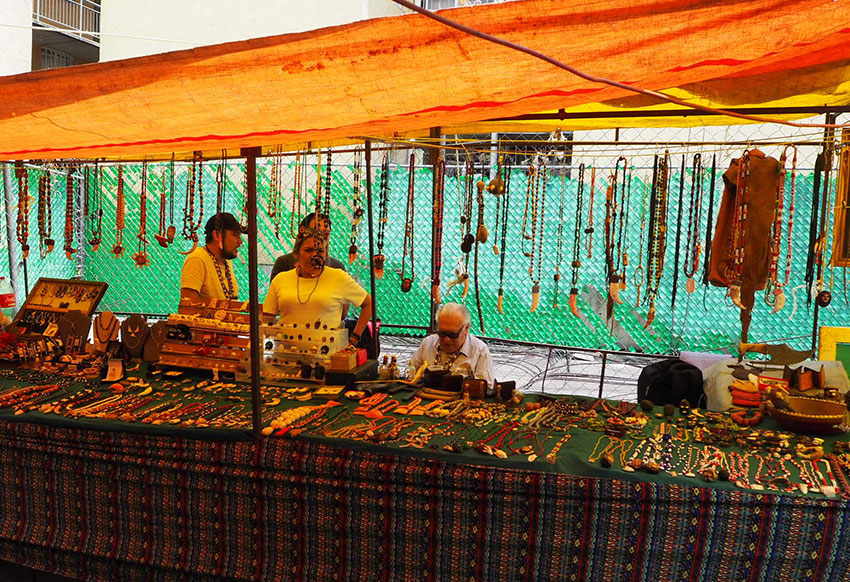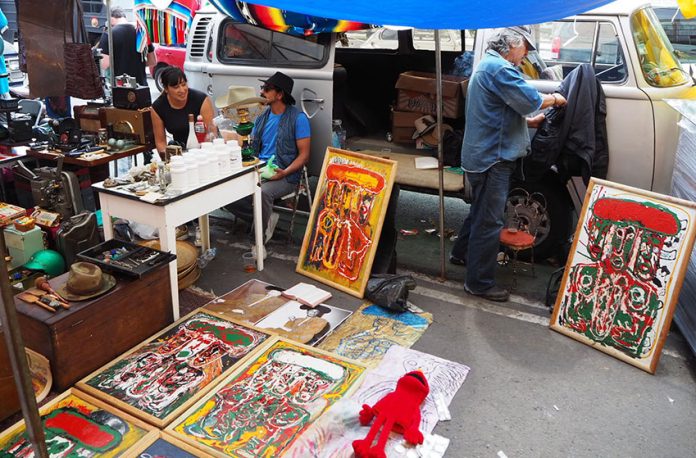Tianguis La Lagunilla is considered the best among Mexico City flea markets, its fame having spread across the globe. Many of the best antiques and collectibles dealers from throughout the city come every Sunday to put out the cream of their crop.
Lagunilla is a tourist haven because foreign currency can travel a bit further. Yet, it’s still a weekly ceremony for hardcore locals.
Some come to find a good deal, some come to drop serious coin on antiques, and some come just to party. La Lagunilla is the perfect cure for Saturday night’s hangover – and expect to see some folks with bloodshot eyes bumbling through the crowd.
Much is written about the dangers at the Tianguis, the surrounding daily market and the neighborhood, but it’s usually overblown. As is recommended when navigating any crowds in the city, keep your gear close, your eyes open and don’t wander too far from the market doors. But the great majority of visitors are there purely for the experience.
Not much is pure trash at Lagunilla – it’s a survival of the fittest sort of place. You can expect to find mid-century modern furniture, vintage clothing, classic antique glassware and original artwork. There are certainly swindlers, but most of the offerings are top tier.

There is a definite look, a fashion sense, to the vendors throughout the Tianguis that mingles swaths of the pirate, cowboy and 1970s rockstar: sunglasses, leather hats, jeans and dangling talismans. It’s a place for personalities.
Old bros fist-bump after a sale, their ponytails jostling in sync – a dance of the salesman. Women in headscarves sell striking, original jewelry with a tarot reading tossed in to sweeten the deal.
They’re the “never wanted a 9-to-5” working class. Among the sellers of Lagunilla, life is about experience, making it work with what you love. And what better way to make it than to travel Mexico’s mountain ranches in search of historic wooden masks that could otherwise be lost. Or to dig through estate sales for old books and original artwork. Or to get stoned and bend metals into ornamental treasures.
You can find everything from a peyote cactus, to a Tiffany lamp, to pieces of pre-Hispanic pottery at Lagunilla. Want to live like the rich and famous and throw away your designer dressing gown each morning? At Lagunilla, you can do it for 800 pesos a day.
It’s said that Guillermo González Camarena, inventor of one of several color television systems, bought everything he needed for his experiments here in 1934.
Just skip the Nazi gear. Most of it isn’t real but are re-creations.

The best way to tackle Lagunilla is with a michelada in hand, the tamarind syrup spilling onto your wrist. Walk through the music: from classic rock, to blues, to cumbia, to reggaeton.
The masks are among the most impressive as is the huge framed artwork. Or you may just end up with a piece of silver or a set of crystal glassware you never knew you needed.
There’s certainly some history in all of that’s offered. It’s just a matter of how forthcoming the seller is with unbridled truth. You can always try to haggle for a deal – no one will scoff. Or ask to flip a coin to see if you can win your bartered price – a favorite among sellers with a gambling bent. Just know you’ll be paying full price if you lose.
If you’re looking for antiques and collectibles, make sure you go to the Tianguis rather than the full market. But the daily market, split into clothing, furniture and food sections, still has plenty to offer.
It’s always worth a walk through the formal clothing section to gander at all the garish-to-gorgeous notions for the perfect wedding or plan that decadent quinceañera your dad never let you have. And how can you not take home a pack of two dozen “Thanks for coming to my First Communion lighters” for 50 pesos?
When you’re done, head over to the party tent to celebrate.
As we waited for a taxi after last Sunday’s visit, an inebriated couple approached us to chat — her with tamarind lips; him with a prominent hot sauce spot on his shirt. They rocked back and forth unsteadily.
“Did you have a good time?” we asked.
“Of course,” she said. “Look at us.”
• Tianguis La Lagunilla starts along the inside of Avenida Paseo de la Reforma, a couple of blocks southeast of Matamoros (Morelos, Mexico City), and continues south and into interior streets –Sundays, 8:00am to 6:00pm. In a taxi, head for the Chedraui at Avenida Paseo de la Reforma and González Bocanegra and take it from there.
This is the 19th in a series on the bazaars, flea markets and markets of Mexico City:
- Central de Abasto, Mexico City’s wholesale market, is a city unto itself
- Black Saturdays at the Punk Market: Tianguis Cultural del Chopo
- At this market are Mexico City’s best murals, which almost no one visits
- Mexico City’s Mercado Medellín, Colonia Roma’s best old-school market
- This mega thrift market said to be the biggest street market in Latin America
- How to find your way through the massive Mercado de la Merced
- From knick-knacks to treasure maps at Portales Antiques Flea Market
- Mercado Martínez de la Torre one of the best food markets in Mexico City
- Choose your adventure of history, gastronomy or art at Saturday Bazaar
- Collected artistic traditions of Mexico are under one roof at this city market
- Sharpen your bargaining skills at the best little antiques market
- Mexico City’s most colorful market is Mercado Jamaica, the flower market
- You’ll find art at Mercado Coyoacán, but the main attraction is food
- MercadoRoma, a Mexican public market reimagined for the 21st century
- Tuesdays in Taxqueña, the flea market of musical brotherhood
- Escandón Market is quintessential middle-class CDMX neighborhood market
- A walk through the Mexico City markets of Colonia La Condesa
- The San Juan market, Mexico City’s epicenter for culinary inquisition
